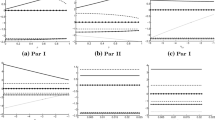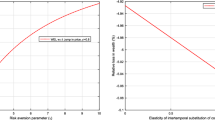Abstract
This paper analyzes the optimal dynamic asset allocation problem in economies with infrequent events and where the investment opportunities are stochastic and predictable. Analytical approximations are obtained, with which a thorough comparative study is performed on the impacts of jumps upon the dynamic decision. The model is then calibrated to the U.S. equity market. The comparative analysis and the calibration exercise both show that jump risk not only makes the investor's allocation more conservative overall but also makes her dynamic portfolio rebalancing less dramatic over time.
Similar content being viewed by others
References
Andrews, D., “Heteroskedasticity and Autocorrelation Consistent Covariance Matrix Estimation. ” Econometrica 59, 817–858, (1991).
Ang, A. and G. Bekaert, “International Asset Allocation with Time-Varying Correlations. ” Manuscript, Standford University, 1999.
Balduzzi, P. and S. Foresi, “Money, Transactions, and Portfolio Choice. ” Ricerche Economiche 50, 57–68, (1996).
Balduzzi, P. and A. Lynch, “Transaction Costs and Predictability: Some Utility Cost Calculations. ” Journal of Financial Economics 52, 47–78, (1999).
Barberis, N. C., “Investing for the Long Run When Returns Are Predictable. ” Journal of Finance 55(1), 225–264, (2000).
Bekaert, G., C. B. Erb, C. R. Harvey and T. E. Viskanta, “Distributional Characteristics of Emerging Market Returns and Asset Allocation. ” Journal of Portfolio Management 24(2), 102–106, (1998).
Bekaert, G. and M. Urias, “Diversification, Integration, and Emerging Market Closed-End Funds. ” Journal of Finance 51, 835–869, (1996).
Benth, F. E., K. H. Karlsen and K. Reikvam, “Optimal Portfolio Management Rules in a Non-Gaussian Market with Durability and Intertemporal Substitution. ” Finance and Stochastics 5(4), 447–467, (2001).
Brandt, M. W., “Optimal Portfolio and Consumption Choice: A Conditional Euler Equation Approach. ” Journal of Finance 54, 1609–1646, (1999).
Brennan, M. J., E. S. Schwartz and R. Lagnado, “Strategic Asset Allocation. ” Journal of Economic Dynamics and Control 21, 1377–1403, (1997).
Campbell, J. and R. Shiller, “The Dividend-Price Ratio and Expectations of Future Dividends and Discount Factors. ” Review of Financial Studies 1, 195–228, (1988).
Campell, J. Y. and L. M. Viceira, “Consumption and Portfolio Decisions When Expected Returns Are Time Varying. ” The Quarterly Journal of Economics 114, 433–495, (1999).
Campell, J. Y. and L. M. Viceira, “Who Should Buy Long Term Bonds?” American Economic Review 91, 99–127, (2001).
Chunhachinda, P., K. Dandapani, S. Hamid and A. J. Prakash, “Portfolio Selection and Skewness: Evidence from International Stock Markets. ” Journal of Banking and Finance 21(2), 143–167, (1997).
Das, S. and R. Uppal, “International Portfolio Choice with Systemic Risk. ” Manuscript, Harvard University, 1998.
Fama, E. F. and K. R. French, “Dividend Yields and Expected Stock Returns. ” Journal of Financial Economics 22, 3–26, (1988).
Hamilton, J. D., Time Series Analysis. Princeton, NJ: Princeton University Press, 1994.
Harvey, C. R., “Predictable Risk and Returns in the Emerging Markets. ” Reviewof Financial Studies 8(3), 773–816, (1995).
Hodrick, R., “Dividend Yields and Expected Stock Returns: Alternative Procedures for Inference and Measurement. ” Review of Financial Studies 5, 141–161, (1989).
Honoré, P., “Pitfalls in Estimating Jump-Diffusion Models. ” Manuscript, The Aarhus School of Business, Denmark, 1998.
Kallsen, J., “Optimal Portfolios for Exponential Lévy Processes. ” Mathematical Methods of Operations Research 51, 357–374, (2000).
Kiefer, N. M., “Discrete Parameter Variation: Efficient Estimation of a Switching Regression Model. ” Econometrica 46, 427–434, (1978).
Kim, T. S. and E. Omberg, “Dynamic Nonmyopic Portfolio Behavior. ” Review of Financial Studies 9, 141–161, (1996).
Liu, J., “Portfolio Selection in Stochastic Environments. ” Manuscript, UCLA, 1998.
Liu, J., F. Longstaff and J. Pan, “Dynamic Asset Allocation with Event Risk. ” Journal of Finance, (2002), forthcoming.
Lynch, A. W., “Portfolio Choice and Equity Characteristics: Characterizing the Hedging Demands Induced by Return Predictability. ” Manuscript, New York University, 1999.
Merton, R. C., “Lifetime Portfolio Selection under Uncertainty: The Continuous Time Case. ” Review of Economics and Statistics 51, 247–257, (1969).
Merton, “Optimum Consumption and Portfolio Rules in a Continuous Time Model. ” Journal of Economic Theory 3, 373–413, (1971).
Merton, “Option Pricing When the Underlying Stock Returns Are Discontinuous. ” Journal of Financial Economics 3, 125–144, (1976).
Newey, W. K. and K. D. West, “A Simple, Positive Semi-Definite, Heteroskedasticity and Autocorrelation Consistent Covariance Matrix. ” Econometrica 55, 703–708, (1987).
Nietert, B., “Dynamics Portfolio Selection and Risk-Return Trade Off With Respect to Stock Price Jumps in Continuous Time. ” Working paper, Passau University, Germany, 1997.
Press, S. J., “A Compound Events Model for Security Prices. ” Journal of Business 40(3), 317–335, (1967).
Rishel, R. “Modeling and Portfolio Optimization for Stock Prices Dependent on External Events. ” Proceedings of 38th IEEE Conference on Decision and Control, 2788–2793, (1999).
Siegel, J. J., Stocks for the Long Run. Burr Ridge, IL: Richard D. Irwin, 1994.
Author information
Authors and Affiliations
Rights and permissions
About this article
Cite this article
Wu, L. Jumps and Dynamic Asset Allocation. Review of Quantitative Finance and Accounting 20, 207–243 (2003). https://doi.org/10.1023/A:1023699711805
Issue Date:
DOI: https://doi.org/10.1023/A:1023699711805




